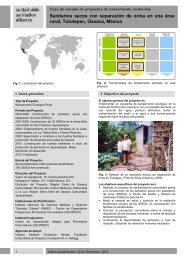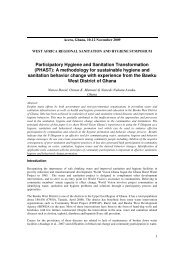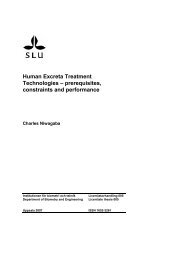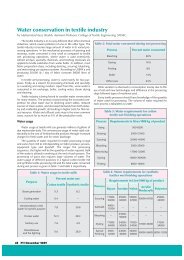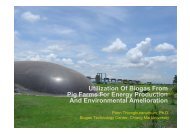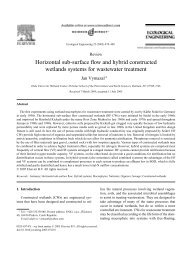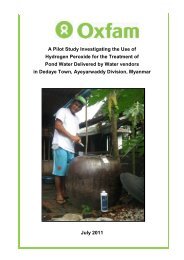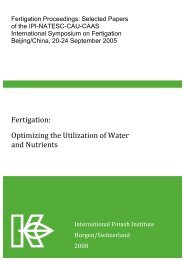qualitative water demand management for rural ... - SSWM
qualitative water demand management for rural ... - SSWM
qualitative water demand management for rural ... - SSWM
Create successful ePaper yourself
Turn your PDF publications into a flip-book with our unique Google optimized e-Paper software.
7. VOLATILE AND SEMIVOLATILE ORGANIC COMPOUNDS IN NATOV CATCHMET<br />
Some springs in the Natuf drainage area, which is located in the Western aquifer and to the west<br />
of Ramallah city in the West Bank in Palestine, has been found to contain traces of Volatile Organic<br />
Compounds (VOC), and larger amounts of Semi-Volatile Organic Compounds (SVOC). Since VOC<br />
are easily removed by good aeration and the concentrations of VOC found from the analysis of<br />
spring's <strong>water</strong> were less than 2 mg/L, which proves that these springs are located in shallow perched<br />
aquifers and are well aerated. SVOC concentrations in ground<strong>water</strong> depend on the compound type,<br />
site-specific geology, hydrology and anthropogenic factors. SVOC are originated mainly from<br />
excessive use of pesticides, herbicides and from petroleum products. They are hardly degradable<br />
species and can remain attached to soil particles <strong>for</strong> longer time, which means that their concentration<br />
is accumulative. The fact that many kinds of pesticides and herbicides are being used by farmers in<br />
the area <strong>for</strong> grapes, figs and even <strong>for</strong> olive fields. Such compounds are toxic to mankind, cattle and<br />
affects quality of ground<strong>water</strong> in the area. The variation of concentration of SVOC from one spring to<br />
another and from one year to another can be related to hydrological and anthropogenic factors only. It<br />
can be noticed that the concentration of Alkanes, Alkenes, Cycloalkanes and cycloalkenes has<br />
increased from 129ppm as an accumulative value in the year 1999 to a value of 316ppm in the year<br />
2000.<br />
8. HYDROCHEMICAL ASSESSMENT OF NATOV CATCHMENT SPRINGS<br />
The <strong>water</strong> spring samples of Ein El Maasal, Ein Qinia, Ein Harasha, Ein El Balad – Surda, Ein Arik,<br />
Ein Mutzbah, Ein Um Aisha and Ein Shik Yousef were analyzed hydrochemically in wet and dry<br />
seasons <strong>for</strong> the year 1999/2000. The analyzed spring reveals of Ca-HCO3 type, Ca-Mg-HCO3 type in<br />
wet and dry seasons, respectively. All of them reveal of no pollution. The trace elements of Si, Cd, Sr,<br />
B, Zn, Mo, P, Cu, Fe, Ni, Pb, Ag, V, Cr and Mn reveal that the springs are enriched with S and Si. The<br />
average of S and Si is 10 and 4 mg/L, respectively. Sulfer shows its maximum limit at the Ein<br />
Mutzbah (20 mg/L), while the silicon shows its maximum limit at Ein Massal. Ein Mutzbah shows a<br />
high concentration of NO3 and SO4 due to the nearby cesspits that are of direct affect to the spring.<br />
Two spring cases of a non-contaminated spring Ein Areek and a contaminated spring Ein Mutzbah<br />
were reported. The Hydrochemical parameters of Ca as well as Mg in Ein Misbah spring show an<br />
increasing trend, while the other parameters show a decreasing trend from the start of winter to its<br />
end.<br />
9. SPRING WATER QUALITY IN HEBRON<br />
Thirty <strong>water</strong> spring samples were analysed hydrochemically <strong>for</strong> the Beit Ula springs / western<br />
Hebron reveals that the two springs of Mohammad Yousef and Sharawi showed high concentration of<br />
Nitrates (62 mg/L). The EC of these two springs are 1077 and 1137 micro Semins/cm, respectively.<br />
The two springs showed also too numerous to be counted from total and fecal coli<strong>for</strong>ms. This is due<br />
to the infiltrated nearby cesspits to those springs in the area, the high pH (8.5) enrich this waste<strong>water</strong><br />
cesspits pollution results. Another two springs (Al Far and Fawzi Al Adam)showed a high<br />
concentration of chloride, 248 and 277 mg/L and sulphate (55 and 64 mg/L), respectively. This is due<br />
to the agricultural activities of the fertilizers that are used by the farmers in the agricultural fields<br />
nearby those springs.<br />
10. TREATED WASTEWATER ANALYSIS IN RAMALLAH<br />
Treated waste<strong>water</strong> samples in the year 2000 were analyzed <strong>for</strong> major ions from the waste<strong>water</strong><br />
flow outlet in Beitunia area near Ramallah. The waste<strong>water</strong> type reveals of Na-Cl type. The average<br />
of NO3 is found to be 64 mg/L, which is considered to be good treated waste<strong>water</strong> to be recharged<br />
within the catchment.<br />
388



